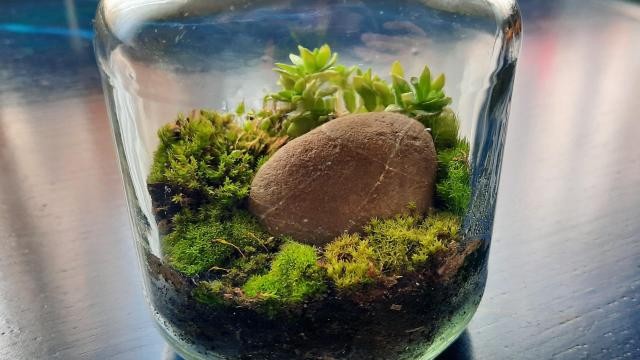Try as I might to keep my indoor plants alive, I am not a natural plant mum. If you’re similarly incompetent, but still want to keep a little slice of nature in your home, let me present to you: the glorious ecosphere.
Your science fair days may be long behind you, but as the #ecosphere tag on TikTok proves, these little self-sustaining worlds can be a beautiful alternative to caring for potted plants. In addition to their visual appeal, the biggest selling point of creating your own ecosphere is that it keeps itself alive. Once you seal it up, there’s no mess or upkeep involved. Throw in some tiny creatures (read: snails!) who love to keep to themselves, and you’ve leveled up your indoor plant game at no extra cost to you.
There are plenty of ecospheres you can purchase ready-made, but below we’ll take you through the simple manual method of using materials from your local environment. So gather up some kids (preferably your own) or give yourself a solo science adventure by creating an ecosphere for your home today.
What are ecospheres?
An ecosphere is basically a closed ecological system (like Earth), but on a much smaller scale. For our purposes, it’s a self-contained, self-sustaining mini-world that you can keep in a jar on your desk.
You can get into the science of how they work here, but all you need to know is that when they’re set up properly, an ecosphere’s own plants, sediment, and animals provide everything the environment needs to survive. They don’t need feeding, filtration, or anything other than sunlight to thrive, and they can last several years.
Ecospheres are also, well, trendy. All year I’ve gotten targeted ads for closed ecosystems you can buy and ship directly to your home, but personally, I’m more interested in the DIY sense of accomplishment of making my own. But if you’re looking for a guaranteed aesthetic, there is no shortage of ecospheres to shop online (especially on craft sites like Etsy).
A (brief) guide to making your own ecosphere
To make the best ecosphere possible, I recommend turning to video examples (like this one) or to in-depth blog posts (like this one) for step-by-step tips. In the meantime, here’s a brief overview of what’s in store.
What you’ll need
Making your own ecosphere is relatively cheap and easy. Once you identify a natural water source near your home, here are the other materials you’ll need.
- A clear, sealable container. Mason jars, empty glass bottles, or even Christmas ornaments are popular choices. You want to be able to observe the life inside your ecosphere, so choosing the right container is a crucial first step.
- A large bowl, spoon, or ladle to scoop water into your clear container.
- A suction device, like a turkey baster, to gather organic material for your ecosystem.
- A small net to gather little creatures like snails (optional, but highly encouraged).
What you’ll do
- Visit a local creek, stream, or pond with vegetation. Think of making your ecosphere like taking a slice of an already thriving environment. You need to gather materials that already live together, so source everything all from one place.
- Add water, sediment and soil to your container.
- Add a few plants from the water source to your container.
- Go hunting for some little snails or small crustaceans to add (they might be hiding under leaves in the water).
- Seal it up and plant your ecosphere in a sunny-ish spot.
- Sit back and watch life bloom before your very eyes.
Final reminders
Your ecosphere will be very murky at first, but this will settle over a couple of days. Algae will typically grow and establish itself from soil and rocks added, but keep in mind that larger animals and insects will not survive in a closed ecosystem like this. And finally, all your ecosphere needs from outside the jar is a little sunlight — preferably indirect.

Leave a Reply
You must be logged in to post a comment.